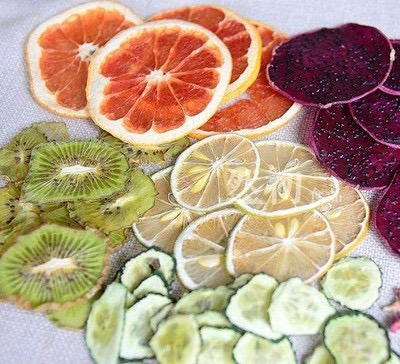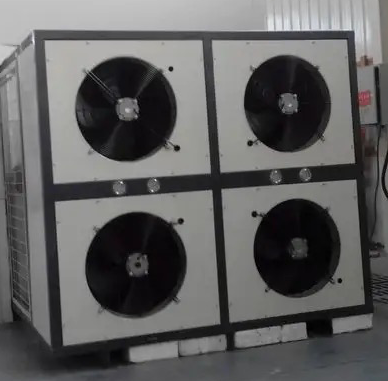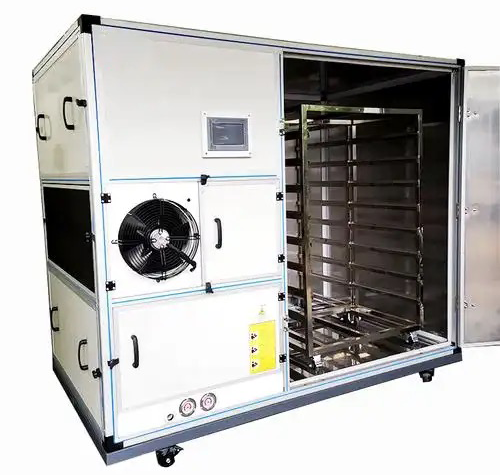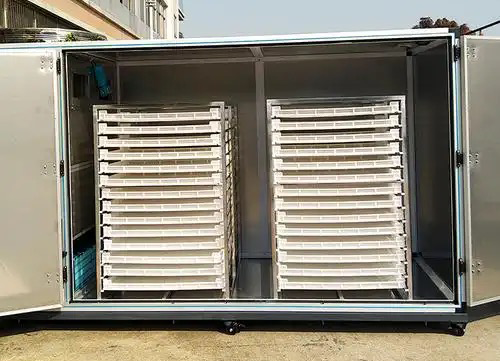
Content Menu
● Understanding Traditional Dryers
● What Is Heat Pump Dryer Technology?
>> Key Components of Heat Pump Dryers
● How Heat Pump Dryers Work
● Advantages of Heat Pump Dryer Technology
● Applications in Food Processing
● Comparing Heat Pump Dryers with Traditional Dryers
● Challenges and Considerations
● Future Trends in Food Drying Technology
● Conclusion
● FAQ
>> 1. What is a heat pump dryer?
>> 2. How does a heat pump dryer work?
>> 3. What are the benefits of using a heat pump dryer for food processing?
>> 4. Can heat pump dryers be used for all types of food?
>> 5. Are heat pump dryers more expensive than traditional dryers?
In the world of food preservation, drying is a crucial method that extends shelf life and maintains nutritional quality. As a manufacturer of food drying machines in China, we are committed to providing innovative solutions for our international partners. One of the most significant advancements in drying technology is the heat pump dryer. This article explores how heat pump dryer technology differs from traditional dryers, focusing on its benefits, operational mechanisms, and applications in food processing.

Understanding Traditional Dryers
Traditional dryers have been used for decades in various industries, including agriculture and food processing. These dryers primarily rely on direct heat sources, such as gas or electric heating elements, to evaporate moisture from food products. The most common types of traditional dryers include:
- Convection Dryers: These use hot air to transfer heat to the food product. The heated air circulates around the food, removing moisture through convection.
- Radiant Dryers: These utilize infrared radiation to heat the food directly. The energy emitted heats the surface of the food, causing moisture to evaporate.
- Drum Dryers: In this method, a rotating drum coated with a thin layer of food is heated externally. As the drum rotates, moisture evaporates from the food.
While effective, traditional dryers have several limitations:
- Energy Inefficiency: They often consume more energy than necessary due to continuous heating.
- Temperature Control: Maintaining consistent temperatures can be challenging, leading to uneven drying and potential nutrient loss.
- Environmental Impact: Traditional dryers can emit significant greenhouse gases if fossil fuels are used as a heat source.
What Is Heat Pump Dryer Technology?
Heat pump dryer technology represents a paradigm shift in drying processes. Unlike traditional dryers, heat pump dryers utilize a refrigeration cycle to transfer heat efficiently. This technology allows for lower temperature drying while maintaining high energy efficiency.
Key Components of Heat Pump Dryers
1. Evaporator: Absorbs heat from the environment and cools down the refrigerant.
2. Compressor: Increases the pressure and temperature of the refrigerant gas.
3. Condenser: Releases absorbed heat into the drying chamber while condensing the refrigerant back into a liquid state.
4. Expansion Valve: Reduces the pressure of the refrigerant before it enters the evaporator again.
How Heat Pump Dryers Work
Heat pump dryers operate on a closed-loop system that continually recycles air within the drying chamber. Here's how it works:
1. Air Circulation: Air is drawn from the drying chamber and passed over the evaporator coil where it absorbs moisture from the food product.
2. Heat Absorption: The evaporator coil extracts heat from the air, causing moisture to condense on its surface.
3. Refrigeration Cycle: The compressor then compresses this refrigerant gas, raising its temperature and pressure.
4. Heat Release: The hot gas moves to the condenser coil where it releases heat back into the drying chamber, warming the air and facilitating further moisture evaporation.
5. Continuous Process: The cycle repeats as air continues to circulate through the system, allowing for efficient moisture removal at lower temperatures.
Advantages of Heat Pump Dryer Technology
Heat pump dryers offer several advantages over traditional drying methods:
- Energy Efficiency: They can reduce energy consumption by up to 50% compared to conventional dryers due to their ability to recycle heat.
- Lower Operating Temperatures: This feature helps preserve sensitive nutrients in food products that might be lost at higher temperatures.
- Uniform Drying: The controlled environment ensures consistent moisture removal across all products, reducing spoilage and improving quality.
- Reduced Environmental Impact: By using less energy and potentially utilizing renewable energy sources, heat pump dryers contribute to lower carbon emissions.

Applications in Food Processing
Heat pump dryer technology is particularly beneficial in various food processing applications:
- Fruits and Vegetables: Maintaining color and flavor while removing moisture effectively is essential for preserving market value. Heat pump dryers can dry fruits like apples and vegetables like carrots without compromising their nutritional content or taste.
- Herbs and Spices: Preserving essential oils and volatile compounds during drying is critical for maintaining flavor profiles in herbs such as basil or oregano. Heat pump technology allows for gentle drying that retains these valuable characteristics.
- Meat Products: Ensuring safety by effectively removing moisture without compromising quality is vital in meat processing. Heat pump dryers can dry meats like jerky at lower temperatures while preventing bacterial growth.
- Dairy Products: Facilitating low-temperature drying processes for milk powders or cheese products helps maintain their texture and flavor integrity during production.
Comparing Heat Pump Dryers with Traditional Dryers
To better understand how these technologies differ, let's compare them side by side:
| Feature | Traditional Dryers | Heat Pump Dryers |
| Energy Efficiency | Lower efficiency; higher consumption | Up to 50% more efficient |
| Temperature Control | Difficult to maintain | Consistent low-temperature operation |
| Moisture Removal | Can be uneven | Uniform moisture extraction |
| Environmental Impact | Higher emissions | Lower emissions |
| Nutrient Preservation | Higher risk of nutrient loss | Better preservation |
Challenges and Considerations
While heat pump dryer technology offers numerous advantages, there are also challenges associated with its implementation:
- Initial Investment Costs: The upfront costs for purchasing heat pump dryers can be higher than traditional options due to advanced technology and components involved.
- Maintenance Requirements: Regular maintenance is essential for keeping these systems running efficiently; neglect can lead to reduced performance over time.
- Training Needs: Operators may require training to understand how to use and maintain this technology effectively, which could involve additional time and resources.
Despite these challenges, many businesses find that the long-term benefits outweigh initial hurdles as they enjoy reduced operational costs and improved product quality over time.
Future Trends in Food Drying Technology
As technology continues to evolve, several trends are emerging within the realm of food drying:
- Integration with IoT (Internet of Things): Future models may incorporate IoT capabilities allowing for remote monitoring and control of drying processes via smartphones or computers, enhancing operational efficiency further.
- Sustainability Focus: With increasing awareness about environmental impacts, manufacturers are likely to develop even more energy-efficient models that utilize renewable energy sources like solar power alongside heat pump technology.
- Advanced Automation: Automation will play a significant role in streamlining operations within food processing facilities; automated systems can optimize drying times based on real-time data analysis ensuring consistent results across batches.
Conclusion
In conclusion, heat pump dryer technology offers significant advantages over traditional drying methods in terms of energy efficiency, temperature control, and environmental impact. As a leading manufacturer of food drying machines in China, we are dedicated to providing OEM services that leverage this innovative technology for our international partners. By adopting heat pump dryers, businesses can enhance product quality while reducing operational costs and environmental footprints.
The future looks promising as advancements continue in this field; embracing these technologies will not only benefit manufacturers but also contribute positively towards sustainable practices within the industry as a whole.

FAQ
1. What is a heat pump dryer?
A heat pump dryer is an advanced drying machine that uses a refrigeration cycle to efficiently remove moisture from products at lower temperatures compared to traditional dryers.
2. How does a heat pump dryer work?
It works by circulating air through an evaporator where moisture is absorbed. The refrigerant is then compressed and heated before releasing warm air back into the drying chamber to continue removing moisture.
3. What are the benefits of using a heat pump dryer for food processing?
The benefits include energy efficiency, preservation of nutrients due to lower temperatures, uniform drying results, and reduced environmental impact through lower energy consumption.
4. Can heat pump dryers be used for all types of food?
Yes, they are versatile and can be used for various foods including fruits, vegetables, herbs, spices, meats, and dairy products while maintaining quality during the drying process.
5. Are heat pump dryers more expensive than traditional dryers?
While they may have a higher initial investment cost, their energy efficiency leads to lower operating costs over time, making them more economical in the long run.












